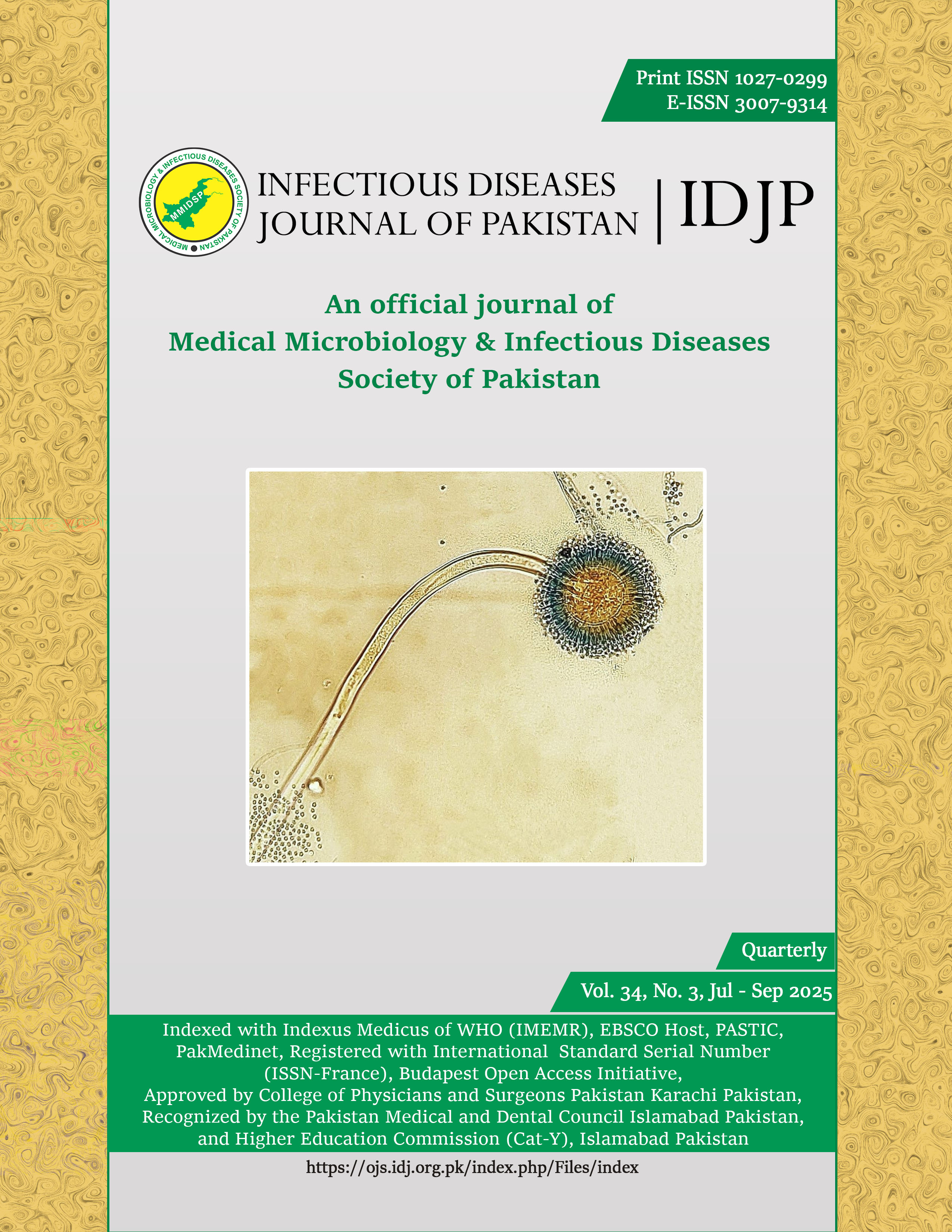Prevalence of HIV-related risk behaviors in the general population of Malakand division, Khyber Pakhtunkhwa: A community cross-sectional survey
DOI:
https://doi.org/10.61529/idjp.v34i3.447Abstract
Background: HIV-related risk behaviors are grossly under-reported in rural Pakistan despite their public health addresses. It is important to know its frequency in Malakand Division for prevention strategies.
Material and Methods: A community-based cross-sectional study was conducted in eight districts of Malakand Division, Khyber Pakhtunkhwa, from January 2023 to December 2024. A random sample of 2,630 individuals (≥15 years) was surveyed through interviewer-administered home questionnaires on sexual practices, substance use, and socio-behavioural risks. Data were analyzed using SPSS v26, with results presented as counts and percentages.
Results: The number of male participants was 1,595 (60.6%) and female participants were 1,035 (39.4%). Unprotected sex was 210/300 (70.0%) in Dir Upper and 150/250 (60.0%) in Shangla vs. 20/52 (38.5%) for Chitral). IV drug sharing was more prevalent in Chitral (10/52, 19.2%) than Swat district (38/480, 7.9%). Polygamous relations were seen in 15/100 (15.0%) of the Swat and 15/52 (28.8%) of Chitral group. Sex work was reported by 10/110 (9.1%) in Buner and 10/52 (19.2%) in Chitral. Highest rate of alcohol use was observed in patients from Dir Upper (120/300, 40.0%) followed by Shangla (90/250, 36.0%). Child marriage was prevalent in Shangla (35/250, 14.0%) and Chitral (8/52, 15.4%).
Conclusion: HIV-related risk behaviours were regionally diverse; unprotected sex and substance use was common in Dir Upper and Shangla, whereas needle sharing and multiple partners was more prevalent among people from Chitral.
Keywords: Adolescent, HIV Infections/ epidemiology, Pakistan, Risk-Taking, Sexual behavior, Substance-Related disorders, Unsafe sex.
References
UNAIDS. Global HIV & AIDS statistics — Fact sheet 2023. Geneva: UNAIDS; 2023. Available from: https://www.unaids.org/en/resources/fact-sheet
van Schalkwyk C, Stover J, Mahiane G, Mahy M, Marsh K, Nakagawa F, et al. Updated data and methods for the 2023 UNAIDS HIV estimates. J Acquir Immune Defic Syndr. 2024; 95(Suppl 1): S1–S4. DOI: https://doi.org/10.1097/qai.0000000000003344
Raza HA, Raja MHR, Khakwani MM, Jamil B. Pakistan’s HIV high-risk populations: Critical appraisal of failure to curtail spread beyond key populations. IJID Regions. 2024; 11: 100364. DOI: https://doi.org/10.1016/j.ijregi.2024.100364
Mir F, Mahmood F, Siddiqui AR, Baqi S, Abidi SH, Kazi AM, et al. HIV infection predominantly affecting children in Sindh, Pakistan, 2019: A cross-sectional study. Lancet Infect Dis. 2020; 20(3): 362–70. DOI: https://doi.org/10.1016/s1473-3099(19)30743-1
Mir F, Zaidi S, Khan H, Bhatti H, Baqi S, Nathwani AA, et al. Factors associated with HIV infection among children in Larkana District, Pakistan: A matched case-control study. Lancet HIV. 2021; 8(6): e342–52. DOI: https://doi.org/10.1016/s2352-3018(21)00049-7
Emmanuel F, Achakzai BK, Reza T. Prevalence and factors associated with HIV among female sex workers in Pakistan: results from the fifth round of integrated biological and behavioural surveillance. Sex Transm Infect. 2021; 97(6): 446–451. DOI: https://doi.org/10.1136/sextrans-2020-054526
Sameen S, Lakhdir MPA, Azam SI, Asad N. Evaluating knowledge about HIV and discriminatory attitudes among Pakistani women of reproductive age using 2017–18 Demographic Health Survey data. Sci Rep. 2023; 13: 17849. DOI: https://doi.org/10.1038/s41598-023-45117-z
Rana BK, Sarfraz M, Reza TE, Emmanuel F. A Cross-sectional study to assess HIV/AIDS-related stigma and its drivers among dental healthcare providers in Islamabad, Pakistan. Cureus. 2023; 15(10): e46769. DOI: https://doi.org/10.7759/cureus.46769
Santhya KG, Jejeebhoy SJ. Sexual and reproductive health and rights of adolescent girls: Evidence from low- and middle-income countries. Glob Public Health. 2019; 14(9): 1313-27. DOI: https://doi.org/10.1080/17441692.2014.986169
Mumtaz G, Weiss HA, Thomas SL, Riome S, Setayesh H, Riedner G, et al. HIV among people who inject drugs in the Middle East and North Africa: Systematic review and data synthesis. PLoS Med. 2014; 11(6): e1001663.
DOI:https://doi.org/10.1371/journal.pmed.1001663
Baral S, Rao A, Sullivan P, Phaswana-Mafuya N, Diouf D, Millett G, et al. Disconnect between individual- and population-level HIV prevention benefits of condoms. Lancet HIV. 2019; 6(9): e623-9. DOI: https://doi.org/10.1016/s2352-3018(19)30 226-7
Ortblad KF, Baeten JM, Cherutich P, Wamicwe J, Wasserheit JN. The arc of HIV epidemics in sub-Saharan Africa: new challenges with concentrating epidemics in key populations. Curr HIV/AIDS Rep. 2019; 16(4): 259-69. DOI: https://doi.org/10.1097/coh.0000000000000569
Shah SA, Altaf A, Mujeeb SA, Memon A. An outbreak of HIV infection among injection drug users in a small town in Pakistan: potential for national implications. Int J STD AIDS. 2004; 15(3): 209. DOI: https://doi.org/10.1258/095646204322916713
Rai MA, Warraich HJ, Ali SH, Nerurkar VR. HIV/AIDS in Pakistan: the battle begins. Retrovirology. 2007; 4: 22.
DOI: https://doi.org/10.1186/1742-4690-4-22
Zafar T, Brahmbhatt H, Imam G, ul Hassan S, Strathdee SA. HIV knowledge and risk behaviors among Pakistani and Afghani drug users in Quetta, Pakistan. J Acquir Immune Defic Syndr. 2003; 32(4): 394-8. DOI: https://doi.org/10.1097/00126334-200304010-00008
Deering KN, Amin A, Shoveller J, Nesbitt A, Garcia-Moreno C, Duff P, et al. A Systematic Review of the Correlates of Violence Against Sex Workers American Journal of Public Health. 104; e42_e54. DOI: https://ajph.aphapublications.org/doi/abs/102105/AJPH.2014.301909
Mir F, Mahmood F, Siddiqui AR, Baqi S, Abidi SH, Kazi AM, et al. HIV infection predominantly affecting children in Sindh, Pakistan, 2019: a cross-sectional study. Lancet Infect Dis. 2020; 20(3): 362-70. DOI: https://doi.org/10.1016/s1473-3099(19)30743-1
Mir F, Zaidi S, Khan H, Bhatti H, Baqi S, Nathwani AA, et al. Factors associated with HIV infection among children in Larkana District, Pakistan: a matched case-control study. Lancet HIV. 2021; 8(6): e342-52. DOI: https://doi.org/10.1016/s2352-3018(21)00049-7
United Nations Office on Drugs and Crime (UNODC). World Drug Report 2023. Vienna: UNODC; 2023. Available from: https://www.unodc.org/unodc/data-and-analysis/world-drug-report-2023.html
Ahmed W, Ahmed I, Bhanbhro F, Ali H, Soomro J, Abbas Q, et al. Frequency of pediatric HIV infection among high-risk children admitted to a tertiary institution at Sukkur, Sindh, Pakistan. BMC Infect Dis. 2025; 25: 835. DOI: https://doi.org/10.1186/s12879-025-11256-z
Elwyn G, Barr PJ, Grande SW. Patients recording clinical encounters: A path to empowerment? Assessment by mixed methods. BMJ Open. 2015; e008566. Available from: https://bmjopen.bmj.com/content/bmjopen/5/8/e008566.full.pdf
Downloads
Published
How to Cite
Issue
Section
License
Copyright (c) 2025 Editor Office

This work is licensed under a Creative Commons Attribution-NonCommercial 4.0 International License.



